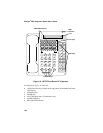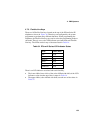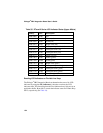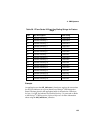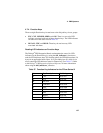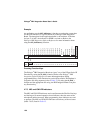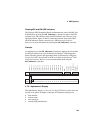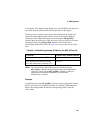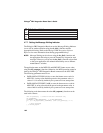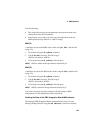
Dialogic
®
PBX Integration Board User’s Guide
Example
An application uses the d42_indicators( ) function to retrieve the current data
for the LCD indicators on a given channel on a Dialogic
®
PBX Integration
Board. The data placed in the application buffer is shown below. If the data
for byte 23 is 0x07, the indicator for SPKR is red and on. Refer to the
Dialogic
®
PBX Integration Software Reference for more information about
using the d42_indicators( ) function.
Line Key 1
00 00 00 00 00 00 00 00 00 00 00 00 00 00 00 00 xx 00 00 00 xx 00 00 07
00 01 02 03 04 05 06 07 08 09 10 11 12 13 14 15 16 17 18 19 20 21 22 23
00 00 xx xx xx xx xx xx xx xx xx xx xx xx xx xx xx xx xx xx xx xx xx xx
24 25 26 27 28 29 30 31 32 33 34 35 36 37 38 39 40 41 42 43 44 45 46 47
Line Key 2
Line Key 3
Line Key 4
Line Key 5
Line Key 6
Line Key 7
Line Key 8
Line Key 9
Line Key 10
Line Key 11
Line Key 12
Line Key 13
Line Key 14
Line Key 15
Line Key 16
Not Used
MWI
CNF Key
FCN Key
Not Used
LNR/SPD Key
ANS Key
SPKR Key
Data
Byte
Data
Byte
ICM
MIC
Pressing Function Keys
The Dialogic
®
PBX Integration Board can “press” any of the DTerm Series III
Function keys using the dx_dial( ) function. Refer to the Dialogic
®
PBX
Integration Software Reference for more information about dialing
programmable keys. Each Function key on the DTerm Series III telephone is
assigned a dial string sequence (refer to
Table 37). By using the dx_dial( )
function and the appropriate dial string, the PBX Integration Board can press
any Function key.
4.7.5. MIC and ICM LED Indicators
The MIC and ICM LED indicators are located between the Flexible Line keys
and the keypad. In normal operation, these indicators show the status of the
microphone and the intercom. When programming, these indicators are used
as prompts. The MIC and ICM LED indicators can take any of the red states
(0x00 – 0x07) listed in
Table 35.
158





